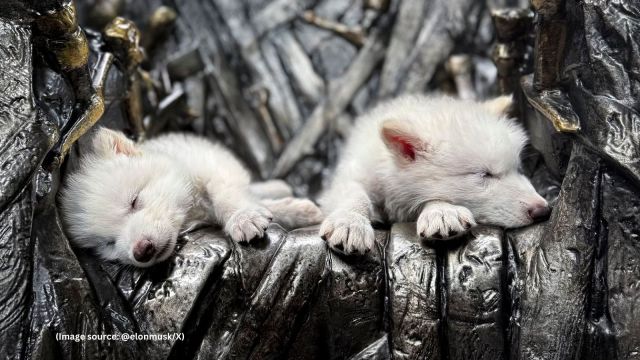Ancient DNA, gene-editing, surrogate dogs: here’s how dire wolves returned from extinction after over 12,000 years
The major accomplishment was made possible by Colossal Biosciences, a Texas-based company specialising in de-extinction efforts.
 The dire wolf, a species that gained widespread fame through HBO's ‘Game of Thrones’ series, once roamed North America as a dominant predator (Image source: @elonmusk/X)
The dire wolf, a species that gained widespread fame through HBO's ‘Game of Thrones’ series, once roamed North America as a dominant predator (Image source: @elonmusk/X)In a groundbreaking achievement, scientists have successfully revived the dire wolf, an ancient species that went extinct nearly 12,500 years ago, using cutting-edge genetic engineering techniques. The two pups that have taken the scientific community by surprise are named Romulus and Remus, CNN reported.
Although they are just six months old, the animals already stand at nearly four feet tall and weigh over 36 kg. This was made possible by Colossal Biosciences, a Texas-based company specialising in de-extinction efforts. The pups were created by harnessing ancient DNA, cloning, and gene-editing technologies, as per the report.
The dire wolf, a species that gained widespread fame through HBO’s ‘Game of Thrones’ series, once roamed North America as a dominant predator. They were larger than modern gray wolves, with thicker fur and stronger jaws.
To bring these creatures back, Colossal Biosciences used the DNA of the gray wolf, the dire wolf’s closest living relative, and a combination of gene-editing and cloning methods. The company managed to produce three modern dire wolf pups, Romulus, Remus, and a three-month-old female named Khaleesi. These pups are currently being raised and studied at a secret location in the United States.
Colossal Biosciences achieved this feat by studying ancient samples of dire wolf DNA, including a 13,000-year-old tooth discovered in Ohio, and a 72,000-year-old skull fragment from Idaho, both of which were part of museum collections. The company’s goal is to revive extinct species, and the success of the dire wolf project marks a major milestone in that mission.
SOUND ON. You’re hearing the first howl of a dire wolf in over 10,000 years. Meet Romulus and Remus—the world’s first de-extinct animals, born on October 1, 2024.
The dire wolf has been extinct for over 10,000 years. These two wolves were brought back from extinction using… pic.twitter.com/wY4rdOVFRH
— Colossal Biosciences® (@colossal) April 7, 2025
SpaceX CEO Elon Musk also reacted to the achievement, sharing his own wish on social media. “Please make a miniature pet woolly mammoth,” Musk posted on X.
Please make a miniature pet wooly mammoth https://t.co/UxoIWmzq6h
— Elon Musk (@elonmusk) April 7, 2025
Colossal’s chief scientist Beth Shapiro explained that the process began by extracting blood cells from a living gray wolf. These cells were then edited using CRISPR technology, altering 20 specific genes. The modified genetic material was inserted into an egg cell from a domestic dog. Once the embryos were ready, they were implanted into surrogate dogs, and after 62 days, the genetically engineered pups were born.
- 01
- 02
- 03
- 04
- 05































